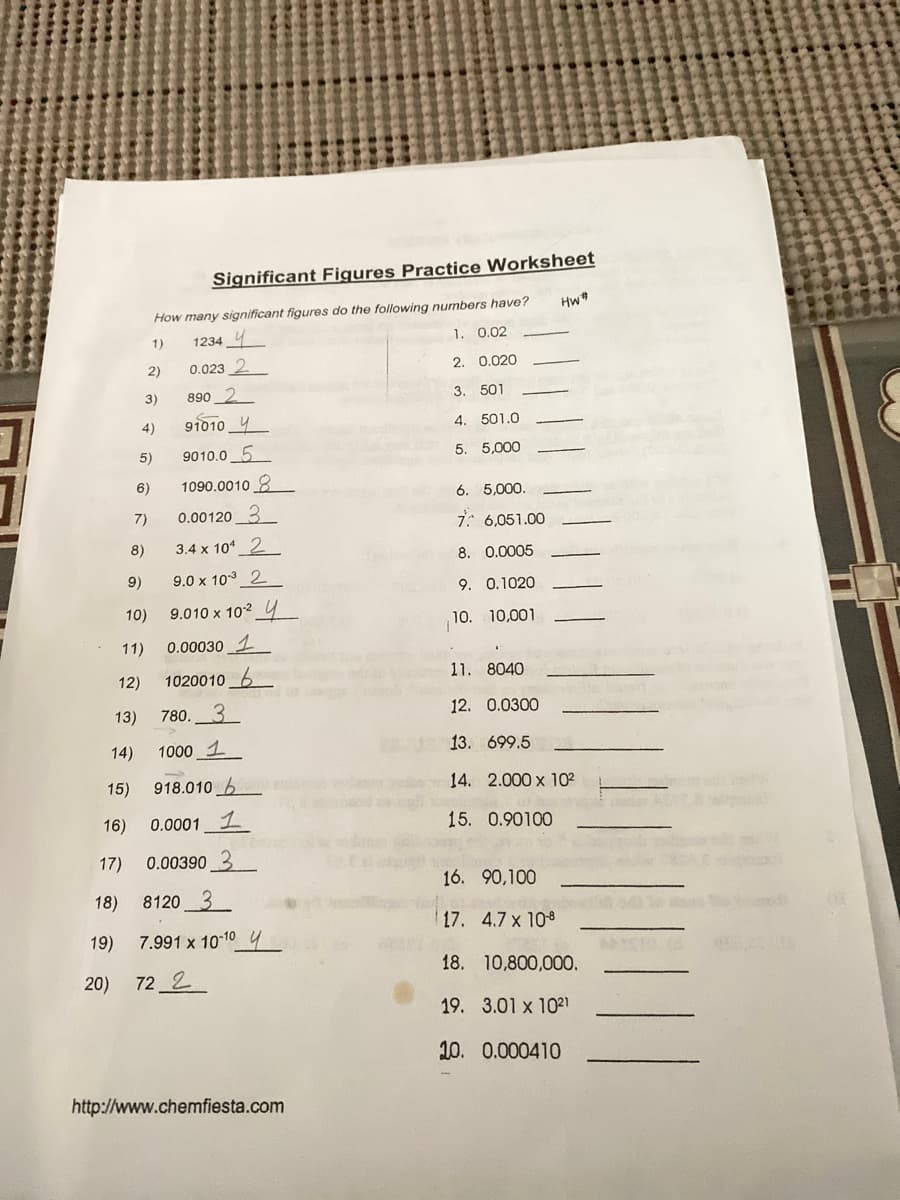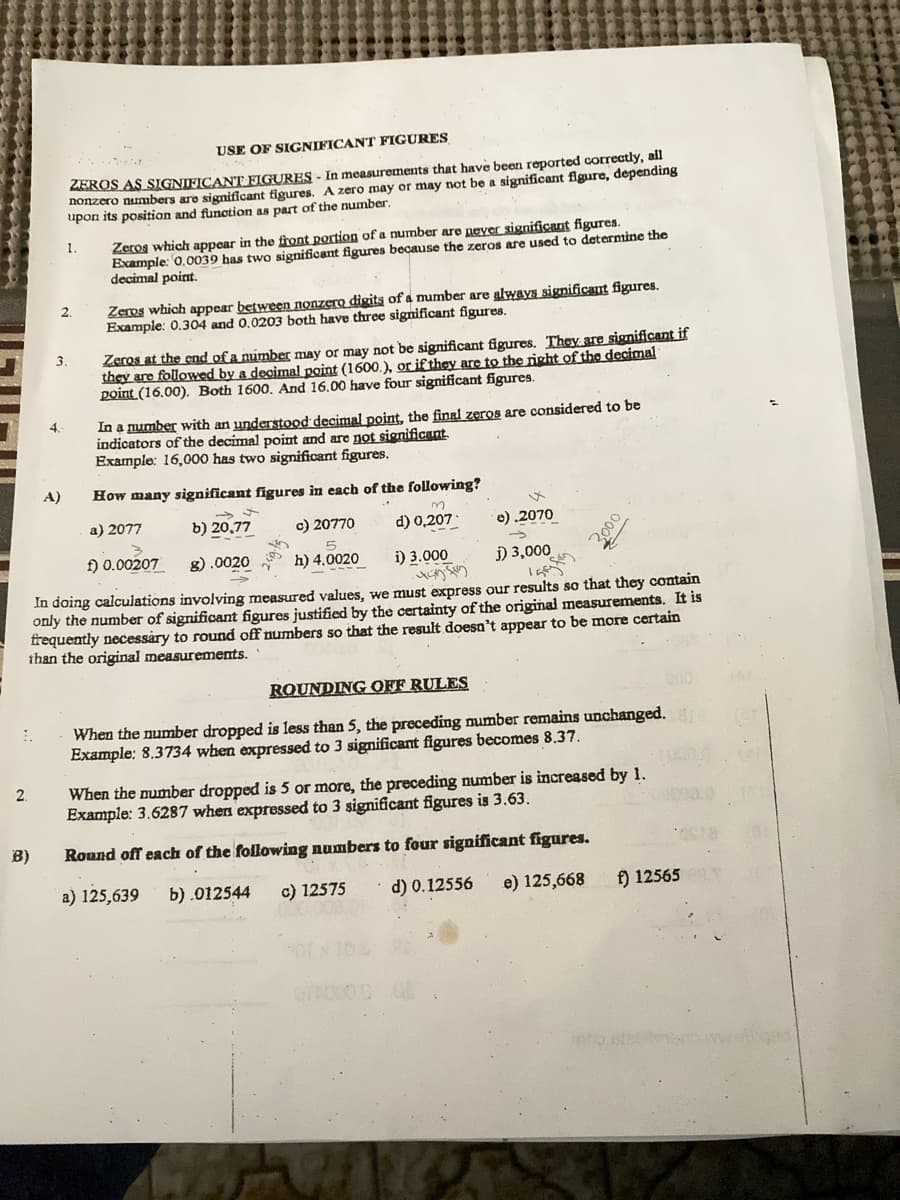Significant Figures Practice Worksheet How many significant figures do the following numbers have? Hw 1) 1234 4 1. 0.02 2) 0.023 2 2. 0.020 3) 890 2 3. 501
Significant Figures Practice Worksheet How many significant figures do the following numbers have? Hw 1) 1234 4 1. 0.02 2) 0.023 2 2. 0.020 3) 890 2 3. 501
General, Organic, and Biological Chemistry
7th Edition
ISBN:9781285853918
Author:H. Stephen Stoker
Publisher:H. Stephen Stoker
Chapter2: Measurements In Chemistry
Section2.4: Uncertainty In Measurement And Significant Figures
Problem 3QQ
Related questions
Question
Please solve all worksheet

Transcribed Image Text:Significant Figures Practice Worksheet
How many significant figures do the following numbers have?
1234 4
Hw
1)
1. 0.02
2)
0.023 2
2. 0.020
3)
890 2
3. 501
4)
91010 4
4. 501.0
5)
9010.05
5. 5,000
6)
1090.0010 8
6. 5,000.
7)
0.00120 3
7: 6,051.00
8)
3.4 x 10 2
8. 0.0005
9)
9.0 x 103 2
9. 0.1020
10)
9.010 x 102 y
10. 10,001
11)
0.00030 1
12)
1020010 _6
11. 8040
13)
780.
3.
12. 0.0300
14)
1000 1
13. 699.5
15)
918.010 b
14. 2.000 x 102
16)
0.0001 1
15. 0.90100
17)
0.00390
16. 90,100
18)
8120 3
17. 4.7 x 108
19)
7.991 x 1010 4
18. 10,800,000.
20) 72 2
19. 3.01 x 1021
10. 0.000410
http://www.chemfiesta.com

Transcribed Image Text:USE OF SIGNIFICANT FIGURES
ZEROS AS SIGNIFICANT FIGURES - In measurements that have been reported correctly, all
nonzero numbers are significant figures. A zero may or may not be a significant figure, depending
upon its position and function as part of the number.
1.
Zeros which appear in the front portion of a number are neyer significant figures.
Example: 0.0039 has two significant figures because the zeros are used to determine the
decimal point.
2.
Zeros which appear between nonzero digits of a mumber are always significant figures.
Example: 0.304 and 0.0203 both have three significant figures.
Zeros at the end of a mimber may or may not be significant figures. They are significant if
they are followYed by a decimal point (1600.), or if they are to the right of the decimal
point (16.00). Both 1600. And 16.00 have four significant figures.
In a mumber with an understood decimal point, the final zeros are considered to be
indicators of the decimal point and are not significant
Example: 16,000 has two significant figures.
4.
A)
How many significant figures in each of the following?
3.
a) 2077
b) 20,77
c) 20770
d) 0,207
e) .2070
f) 0.00207
8).0020
2000
h) 4.0020
i) 3.000
) 3,000
In doing calculations involving measured values, we must express our results so that they contain
only the number of significant figures justified by the certainty of the original measurements. It is
frequently necessáry to round off numbers so that the result doesn't appear to be more certain
than the original measurements.
ROUNDING OFF RULES
When the number dropped is less than 5, the preceding mumber remains unchanged.
Example: 8.3734 when expressed to 3 significant figures becomes 8.37.
2.
When the number dropped is 5 or more, the preceding number is increased by 1.
Example: 3.6287 when expressed to 3 significant figures is 3.63.
B)
Round off each of the following numbers to four significant figures.
a) 125,639
b) .012544
c) 12575
· d) 0.12556
e) 125,668
f) 12565
Expert Solution
This question has been solved!
Explore an expertly crafted, step-by-step solution for a thorough understanding of key concepts.
This is a popular solution!
Trending now
This is a popular solution!
Step by step
Solved in 2 steps

Recommended textbooks for you

General, Organic, and Biological Chemistry
Chemistry
ISBN:
9781285853918
Author:
H. Stephen Stoker
Publisher:
Cengage Learning

General Chemistry - Standalone book (MindTap Cour…
Chemistry
ISBN:
9781305580343
Author:
Steven D. Gammon, Ebbing, Darrell Ebbing, Steven D., Darrell; Gammon, Darrell Ebbing; Steven D. Gammon, Darrell D.; Gammon, Ebbing; Steven D. Gammon; Darrell
Publisher:
Cengage Learning

Introductory Chemistry: A Foundation
Chemistry
ISBN:
9781337399425
Author:
Steven S. Zumdahl, Donald J. DeCoste
Publisher:
Cengage Learning

General, Organic, and Biological Chemistry
Chemistry
ISBN:
9781285853918
Author:
H. Stephen Stoker
Publisher:
Cengage Learning

General Chemistry - Standalone book (MindTap Cour…
Chemistry
ISBN:
9781305580343
Author:
Steven D. Gammon, Ebbing, Darrell Ebbing, Steven D., Darrell; Gammon, Darrell Ebbing; Steven D. Gammon, Darrell D.; Gammon, Ebbing; Steven D. Gammon; Darrell
Publisher:
Cengage Learning

Introductory Chemistry: A Foundation
Chemistry
ISBN:
9781337399425
Author:
Steven S. Zumdahl, Donald J. DeCoste
Publisher:
Cengage Learning